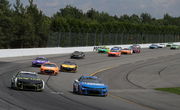
via Imago
NASCAR, Motorsport, USA NASCAR All-Star Race May 21, 2023 North Wilkesboro, North Carolina, USA Team Owner Richard Childress watches from atop Victory Lane during the All Star Race at North Wilkesboro Speedway. North Wilkesboro North Wilkesboro Speedway North Carolina USA, EDITORIAL USE ONLY PUBLICATIONxINxGERxSUIxAUTxONLY Copyright: xJimxDedmonx 20230521_ams_db2_162 Image Credits – Imago

via Imago
NASCAR, Motorsport, USA NASCAR All-Star Race May 21, 2023 North Wilkesboro, North Carolina, USA Team Owner Richard Childress watches from atop Victory Lane during the All Star Race at North Wilkesboro Speedway. North Wilkesboro North Wilkesboro Speedway North Carolina USA, EDITORIAL USE ONLY PUBLICATIONxINxGERxSUIxAUTxONLY Copyright: xJimxDedmonx 20230521_ams_db2_162 Image Credits – Imago
And with that, Saturday’s Xfinity affair in Nashville has been awarded the title of “hottest NASCAR race of the 2024 season so far,” by the Tennessean. Since AccuWeather is currently predicting a 53% probability of thunderstorms in Nashville for Sunday’s race, that record could be deemed safe for now. But as for the Xfinity race? The biggest outlier, apart from John Hunter Nemechek’s second win in the second tier this season, was the considerably warm conditions on hand at Nashville Superspeedway. From the winner to the most notably affected, Riley Herbst, many appeared to be at odds with the weather in Wilson County.
However, that was not the case for Austin Hill, who looked better than much of the field, exiting the excitement after the Xfinity race had finally ended. And the #21 driver barely thinks that’s been an advantage on a day that could’ve turned out to have been very “scary,” courtesy of Mother Nature’s relentless anger.
ADVERTISEMENT
Article continues below this ad
Austin Hill finished fourth to beat the Nashville Heat, concerned about his fellow drivers
The Tennessee Lottery 250 was a truly scorching affair. As Seth Eggert posted the following updates, post-conclusion: “@rileyherbst, @jesselovejr1, and @NoahGragson’s cool shirts all failed during the race. The temperature inside the car was ~130°F, roughly 54.4°C and they all did post-race interviews.” Local sources recorded a temperature reaching “the mid-90s with a heat index of 105.” Even the National Weather Service issued a heat advisory for the Nashville area. But to make things worse for the drivers, already facing grueling conditions inside their respective vehicles, heat tolerance and cool suit failures bothered many the whole afternoon.
For those unfamiliar, the cool suit or shirt is an intricate cooling system worn under the firesuit, normally consisting of thin tubes that circulate cooling fluids across the driver’s body to combat exhaustion from heat in extreme temperature races. They aren’t mandatory, and Bob Pockrass suggests, “The systems are still somewhat in their infancy and teams also trying to do it the best way with minimal impact…”

via Getty
DAYTONA BEACH, FLORIDA – FEBRUARY 11: Austin Hill, driver of the #16 United Rentals Toyota, prepares for practice for the NASCAR Camping World Truck Series NextEra Energy 250 at Daytona International Speedway on February 11, 2021 in Daytona Beach, Florida. (Photo by Chris Graythen/Getty Images)
On the flip side of the cool suits’ debatable effectiveness stands a potential malfunction, not uncommon in NASCAR these days. If a cool suit breaks down at some capacity, it can affect the driver in the exact opposite manner by pumping warm fluid through the tubes under their firesuits. According to reports, an incident of a similar sort happened with Stewart-Haas driver, Riley Herbst, who looked rather worse for wear once his race ended in a commendable P6 position.
Even Richard Childress’s podium finisher, Jesse Love, reportedly faced issues with his cool shirt during the race. But his teammate, who finished just one spot below him, was in visibly better condition. As journalist Peter Stratta rightfully told Austin Hill after the race, “Most of your competitors are on the ground, but you’re looking like you can run another race right now.” He followed up his observation with a question: “How do you feel?”
.@_AustinHill finished 4th in Nashville and says intense heat training has paid off, he’s capable of running another 100 laps right now. #TNLottery250 #NASCAR pic.twitter.com/eobHNZUef2
— Peter Stratta (@peterstratta) June 29, 2024
A calm and collected Hill mindfully replied, “I feel great. We could have ran another hundred laps if we wanted to. It’s just all the training and everything. The preparation that I put into the week. The hydration and everything that I do, I think just helps that…”
Understandably concerned, Hill then shifted the attention to his Xfinity Series colleagues who battled the difficult conditions all through the afternoon, selflessly empathizing, “Who knows? They could have had some type of problem with their cool shirt not working, their helmet blower might not have been working. So definitely can be scary when you’re sitting on the ground like this. So hopefully everyone’s okay. But it was definitely a hot day today. I’m not going to sit here and say that it wasn’t, I was sweating pretty hard.”
The #21 driver then answered another question by Stratta, regarding the possible preparatory measures “going into a race like this where the temperatures are this hot.” He explained, “Just a lot of heat training, saunas, that type of stuff. And then I feel like I’ve always done pretty good with my preparation on hydrating and drinking water and adding electrolytes and sodium packets, and that type of stuff.”
Moving back to the topic of safety among the dehydrated drivers in hot day races like the 2024 Tennessee Lottery 250, Hill would conclude, “But then also, on top of that, I have my cool shirt and my helmet blowing off, and (if) that stuff goes out? I could be one of these guys laying on the ground just like they were. So yeah, it goes back to preparation and being ready for it. But hopefully, everyone’s okay. It looks like most of everybody’s up now.”
These slightly off-track perspectives from an athlete often scrutinized for his questionable on-track attitude toward his fellow drivers shed new light on his true persona beyond the firesuit and racing helmet. But on the debate of cool suits and their effectiveness, let’s head back to 1964 when the contraption-of-the-moment debuted at a NASCAR-sanctioned event.
Trending
Paul Goldsmith, NASCAR’s ‘cool suit’ pioneer
NASCAR Twitter entity, ‘nascarman’ recently shared a tweet following the hot race in Nashville this Saturday with a video captioned, “A lot of talk about cool shirts/suits today in the Nashville heat. Paul Goldsmith introduced the technology to NASCAR in July 1964, inspired by suits astronauts wore in the space capsule.”
ADVERTISEMENT
Article continues below this ad
Paul Goldsmith won the last-ever race on the old Daytona Beach Road Course in 1958. Images exist online of the NASCAR icon championing his space-tech-inspired cool suit from the late ’60s at the Firecracker 400 NASCAR Cup race of 1964 at Daytona International Speedway. But according to a solitary piece of information, “Goldsmith never got the opportunity to try out the suit in the race, as a practice crash between he and Fred Lorenzen prevented both from starting the event.”
As Chris Economaki stated in the video, “Paul Goldsmith, one of the top drivers here at Daytona, has been a pioneer in bringing technical innovations to the speedway. Paul was the first to wear a cool suit…” At the time, Paul had promised, “It will keep us real cool.”
Almost six decades later, Paul’s words still hold, albeit alongside the occasional malfunction of the suit. Paul served as a true pioneer of the sport, pushing for change straight from the driver’s seat, at a time when instruments such as itself were considered commodities. But this also sheds light on the evolving nature of the racing spectrum, even more so with the wider ecological background that has seen a constant increase in temperature since the turn of the last decade.
ADVERTISEMENT
Article continues below this ad
Some questions have been raised surrounding the conditioning of modern NASCAR drivers based on their reactions to heat at Nashville, which, in honesty, would have been grueling for any wheelman, past or present. The brave men and women making their laps on track are certified athletes and must receive that due treatment. After all, on average, a NASCAR driver may lose over 3–8 pounds while spending nearly 3000 calories attempting to claim the chequered under various conditions brought about by stock car racing’s finest echelon.
Nevertheless, do you think the cool suit should be mandatory in hot races, in today’s NASCAR? Let us know your comments below.
ADVERTISEMENT
ADVERTISEMENT
ADVERTISEMENT
ADVERTISEMENT





